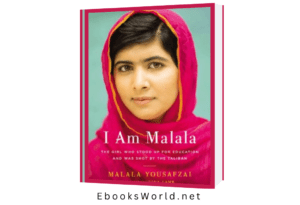I am Malala: The Story of the Girl Who Stood Up for Education and was Shot by the Taliban

“I Am Malala: The Girl Who Stood Up for Education and Was Shot by the Taliban” is an autobiographical memoir written by Malala Yousafzai, co-authored with Christina Lamb. Published in 2013, the book recounts the remarkable life of Malala, a Pakistani girl who defied the Taliban’s oppressive regime to advocate for girls’ education. In this extensive summary, we will delve into the key themes, characters, and the powerful message of resilience and determination that “I Am Malala” conveys.
Summary:
“I Am Malala” opens with a prologue describing the day Malala was shot by the Taliban on a school bus in Pakistan’s Swat Valley. The memoir then shifts to an account of Malala’s early life, giving readers insight into her family background and the cultural and political context of her homeland.
Chapter 1: Before the Taliban
Malala Yousafzai was born on July 12, 1997, in Mingora, a town in Pakistan’s Swat Valley. Her father, Ziauddin Yousafzai, was an educator and an advocate for girls’ education. He named Malala after a legendary Afghan woman who rallied her people against British invaders. Malala’s parents encouraged her and her two younger brothers to pursue education and intellectual curiosity.
In this chapter, Malala reflects on her idyllic early childhood in Swat Valley, a region known for its stunning natural beauty. She describes her love for her homeland and its people, especially her Pashtun culture and traditions.
Chapter 2: The Village
Malala recounts her family’s origins in a small village in the Swat Valley called Shangla. Although her family moved to Mingora, Malala’s connection to her ancestral village and her love for her extended family remain strong. She emphasizes the role of family in shaping her identity.
Chapter 3: My Father the Falcon
Malala’s father, Ziauddin, emerges as a pivotal figure in her life. He ran a school called the Khushal School and College, where he was not only a teacher but also an advocate for education. Ziauddin believed in the power of education to break the cycle of poverty and ignorance in Pakistan.
Through her father’s influence, Malala develops a passion for learning, particularly for books and poetry. She learns to appreciate the importance of knowledge and the transformative potential of education.
Chapter 4: The Village and the Valley
Malala describes the natural beauty of Swat Valley, with its lush green hills and flowing rivers. She shares her early memories of the region’s tranquility and how it gradually changed with the rise of the Taliban.
As the Taliban gained influence in Swat, they imposed strict rules and enforced their extremist interpretation of Islam. This chapter highlights the ominous transformation of Malala’s homeland into a region of fear and repression.
Chapter 5: Why I Don’t Wear Earrings and Pashtuns Don’t Say Thank You
Malala discusses her family’s identity as Pashtuns, an ethnic group with a rich cultural heritage. Pashtunwali, the Pashtun code of conduct, emphasizes values such as hospitality, honor, and revenge. Malala explains how these values shaped her upbringing and her sense of responsibility to speak out against injustice.
In this chapter, Malala also reflects on the gender roles and expectations placed on girls and women in Pashtun society. She reveals her early awareness of gender inequality and her determination to challenge it.
Chapter 6: Children of the Rubbish Mountain
Malala’s advocacy for girls’ education takes root when she visits the “Rubbish Mountain,” a landfill in Mingora where poor families scavenge for recyclables. Malala observes that many girls her age are not in school but working alongside their families in dire conditions.
She is deeply affected by the poverty and lack of educational opportunities for these children, motivating her to take action to change their circumstances.
Chapter 7: The Mufti Who Tried to Close Our School
The book delves into the challenges faced by Malala’s school, the Khushal School and College, as it becomes a target of the Taliban. The Taliban’s growing influence in Swat leads to the closure of girls’ schools, and they issue threats against anyone who resists.
In this chapter, Malala highlights the bravery of her father and other educators who continue to teach girls despite the dangers. Ziauddin’s determination to keep the school open underscores his commitment to education and his belief in the power of knowledge.
Chapter 8: The Autumn of the Earthquake
Malala narrates her experiences during the 2005 Kashmir earthquake, which devastated parts of Pakistan. The earthquake exposes the region’s vulnerability and lack of infrastructure. It also reveals the resilience of the people, who come together to support one another in the face of adversity.
This natural disaster further deepens Malala’s sense of empathy and her desire to make a positive impact on her community.
Chapter 9: Radio Mullah
Malala introduces a significant antagonist in her story, Fazlullah, also known as “Radio Mullah.” Fazlullah is a charismatic Taliban leader who uses an illegal FM radio station to spread propaganda and incite fear among the people of Swat.
The rise of Fazlullah and the spread of extremist ideology intensify the challenges faced by Malala and her family. They must navigate the dangerous landscape of Swat while continuing their advocacy for girls’ education.
Chapter 10: Toffees, Tennis Balls, and the Buddhas of Swat
Despite the increasing threats from the Taliban, Malala continues to attend school and participate in activities she enjoys, such as playing cricket and making toffees. She also reflects on the tragic destruction of the ancient Buddhas of Swat by the Taliban, which symbolizes the loss of cultural heritage in the region.
This chapter underscores Malala’s determination to lead a normal childhood and not succumb to fear.
Chapter 11: The Clever Class
Malala and her classmates are determined to excel in their studies, even as the Taliban’s presence looms over their lives. They share their dreams and aspirations, defying the oppression that seeks to limit their potential.
This chapter highlights the resilience and courage of young girls who continue to pursue education despite the threats they face.
Chapter 12: The Bloody Square
The book takes a darker turn as Malala describes the Taliban’s control over Swat, including their brutal punishments and executions in the town square. Fear and oppression become a daily reality for the people of Swat.
As the Taliban tightens its grip on the region, Malala’s family faces increasing threats, forcing them to make difficult decisions about their future.
Chapter 13: The Diary of Gul Makai
Amid the escalating violence and oppression, Malala becomes a symbol of resistance. She begins writing a blog under the pseudonym “Gul Makai” for the BBC Urdu, sharing her experiences and thoughts on life under the Taliban.
“Gul Makai’s Diary” brings international attention to the plight of girls in Swat and the importance of education. Malala’s writing becomes a powerful tool for advocacy and a source of hope for those who aspire to learn.
Chapter 14: A Funny Kind of Peace
Malala recounts the short-lived ceasefire between the Pakistani military and the Taliban. During this period of relative calm, her family returns to their.







